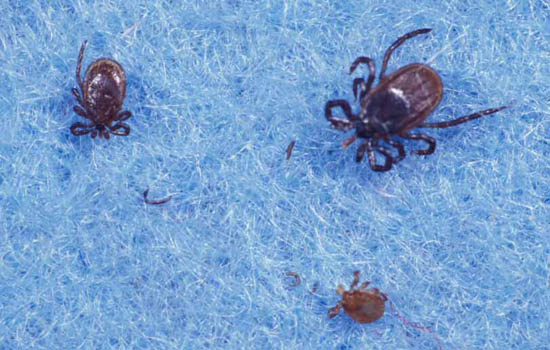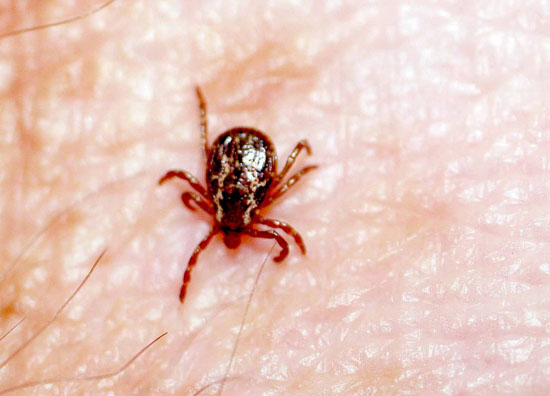Issue 6, June 5, 2017
Ticks
Deer tick, the northern subspecies of the blacklegged tick, spreads Lyme disease, perhaps the fastest rising, most under-reported serious disease in the U.S. There have been an estimated 300,000 cases of Lyme disease annually in the U.S. in recent years. June is the month most likely to get Lyme disease from the bite of a tick nymph. It is important to protect yourself and workers from these giant mites.
One of the major mortality factors in ticks is losing water, so they survive better in moist conditions. The increased rainfall this spring may have increased their numbers. There has been an apparent increase in tick numbers this spring.
Lyme disease, which is transmitted by the deer tick subspecies of the blacklegged tick from native mice, occurs primarily in the northern two-thirds of Illinois. Reported cases in the state have climbed steadily from 35 in 2000 to 287 in 2015. Babesiosis, a parasitic infection of red blood cells is also spread by the blacklegged tick. Powassan virus is also spread from rodents by the blacklegged tick. There have been no cases of Powassan virus reported in Illinois, although 36 cases have been reported in the Midwest, primarily in the northern half of Wisconsin and northeastern Minnesota. Anaplasmosis, previously known as Ehrlichiosis, is a disease with symptoms very similar to those of Lyme disease, is transmitted by the American dog tick and is primarily found in southern Illinois. Rocky Mountain spotted fever is also transmitted by the American dog tick. There was a case of Bourbon virus in eastern Kansas in 2014 with no vector identified, other viruses related to it are spread by ticks and insects.
In recent years, deer ticks have become more common in Illinois, with some areas having numbers as high as states that have higher incidences of Lyme disease, such as Wisconsin and Minnesota. With this increase in numbers, it is expected that Lyme disease will continue to increase in the state.
Blacklegged ticks feed on people as larvae, nymphs, and adults. Larvae are tiny, about the size of the period at the end of a sentence; nymphs are pinhead-sized. Both tend to migrate up the legs and feed in the groin area. Adult blacklegged ticks are teardrop-shaped, reddish brown, and about 1/8 inch long. The deer tick subspecies is found mainly in the northern half of the United States. In the southern United States, the blacklegged subspecies feeds mainly on lizards and birds as immatures and thus do not carry Lyme disease.
Deer tick larvae feed on native mice, picking up Lyme disease, which can be transmitted to people by the tick nymphs and adults. June is when deer tick nymphs are most abundant. The pinhead-sized nymphs are common in forested areas with abundant leaf litter, being the same habitat as native mice that are their primary host.

American dog ticks, commonly known as wood ticks, are the most common in Illinois. They feed as larvae and nymphs on small mammals, only attacking humans when adult. Adults are reddish brown, 3/16 inch long. Females have a silver shield behind the head; males have silver, wiggly lines down the back. In Illinois, these ticks transmit Rocky Mountain spotted fever as well as Anaplasmosis.

Lone star ticks feed on humans and other mammals as larvae, nymphs, and adults. Larvae and nymphs are commonly called seed ticks because of their size. Walking through an area of newly hatched larvae may result in hundreds attacking your legs. Adults are about 1/8 inch in diameter, roundish, and brown; females have a white spot in the middle of the back. Lone star ticks have been implicated in the spread of Heartland virus, cases of which have been detected in Missouri and Tennessee. Lone star tick used to be common in the southern one-third of Illinois and not found in the northern third of the state. It is now common throughout the state.
Ticks are most common in wooded areas and those with tall grass, but they can be associated with any vegetation, particularly in southern Illinois where ticks are more numerous. Landscapers should protect themselves from ticks with repellents containing DEET or picaridin which are sold in major brands such as Off and Cutters. Lemongrass oil repellent is sold as EcoSmart Insect Repellent.
All three of the above repellents are effective, lasting over an hour per application, and commonly several hours. Herbal repellents commonly are not effective for more than 20 minutes, and many have not been tested for safe use. Repellents containing 20-30% DEET are the most effective in repellency and longevity. Higher concentrations of DEET do not last as long, probably because the lotion components in lower concentration products reduce evaporation.
There are also permethrin (Permanone) containing clothes treatments that will kill ticks on clothing. Wear light-colored clothes so that it is easier to see ticks crawling on them. Wearing long pants with the cuffs tucked into boots reduces the likelihood of ticks crawling up the legs.
If a tick is attached, grasp the head area with tweezers where the mouthparts enter the skin, pulling slowly and consistently. The tick will release its mouthparts and come loose. Do not handle the tick. Other methods such as heat and nail polish commonly kill the tick, resulting in locked mouthparts that remain in the wound to cause infection. A tick typically feeds for 24 hours before releasing disease organisms; remove ticks promptly when you find them. (Phil Nixon)
Author:
Phil Nixon